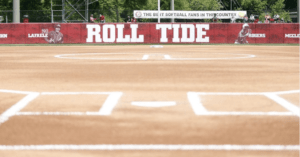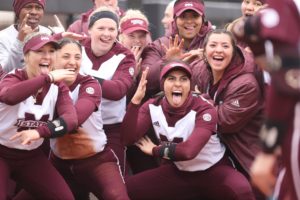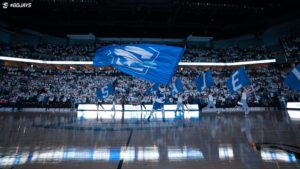SIDs: From the Locker Room to the Stands
Published on March 3, 2022, at 6:49 p.m.
by Katie Holec.
The job of a sports information director (SID) isn’t the most glamorous, but it’s rewarding.
“It’s a unique position where you’re not the star of the show,” Creighton University Sports Information Director Rob Anderson said. “It’s a lot, and there’s a lot going on behind the scenes. The hours are a little different than a lot of jobs, and it’s a lot of travel. But, it’s also something that lots and lots of people would love to do.”
Many SIDs treat their jobs differently because of factors like the team for which they work, the sport, the fans and how they are taught to be a SID.
A SID must always be communicating, while also learning to adapt to the world of communications.
Social media
Over the last decade or so, social media has become prevalent in society, and it has changed the way that SIDs approach their jobs.
Nathan Sheehan, assistant director of athletic communications at The University of Alabama, went through school learning the necessary skills to be a SID, but he has since had to adapt due to the ever-changing world of social media.
“I [worked] two years as a student SID at The University of Iowa and [during that time] Facebook was the thing. But Twitter, not really,” Sheehan said. “Ninety-nine percent of the things that I was taught when I was [in school]. . . we were writing press releases and the journalistic side of things.”

The adjustment to learning new skills that took place during his early career is still relevant as social media continues to evolve.
“You put something out three times a week, and then all sudden it’s not enough. You need [to post] four or five times a week, and then twice a day,” Sheehan explained. “It’s hard because you never really get it right away, because there’s always a new platform on the horizon.”
Anderson has been in the business for over 20 years and has also seen the rise of social media take place.
“It has taken on an increased role here in the last decade-plus,” Anderson said. “Things that never used to be part of the deal are now a huge part of our job.”
Social media created obstacles for SIDs to tackle, but it also allowed them to have more control of their team’s image.
“[The emergence of social media] has helped us be able to tell our own stories through [its platforms] and create our own brand, rather than relying on traditional media outlets,” Sheehan said.
Creating the “mini brand”
Each sport is part of a larger entity, its university. But each team does not follow the university’s brand entirely. Brian Ogden, associate director of communications at Mississippi State University, calls this concept a “mini brand.”

“Each team sets their own personality and brand. We have the overall university brand, but each team, to a degree, has their own little mini brand inside of that,” Ogden said. “[The Mississippi State softball team’s] is built around the personalities of the players and head coach.”
How a “mini brand” is presented on social media is usually directed by the head coach, coaching staff and student-athletes. The concept that is created is then put into action by the SID for potential recruits and fans to see.
Sheehan explained that The University of Alabama volleyball team has a new head coaching staff. The identity that they want to portray for their team this year is different than last year’s staff.
“[When you] scroll through to see the images on the [social media] pages, [they want it to] invoke this idea of toughness or grittiness,” Sheehan said.
Fans
Every SID approaches their team’s image differently, but each one has the same responsibility: to foster the relationship between their team and its fans through the “mini brand.”

“For some fans, their closest connection to the team, outside of watching an event, is that they are following the team on social media. Ideally, [our platform] provides those fans an eye into what’s going on in the program both on and off the court,” Anderson said.
His approach to creating the connection with his team’s fans is showing them the behind-the-scenes: “a locker room celebration or maybe there’s something cool that a team is doing on a trip during an off day, things of that nature,” Anderson explained.
Ogden has a different approach. He mentioned that Mississippi State softball’s account is meant to be “the outlet for the team to cheer” so he runs it accordingly.
“I try to listen to their different dugout chants and everybody’s nicknames. You can catch on pretty quickly with what the girls are actually saying in that dugout, when they’re yelling and celebrating,” Ogden said. “Like, for example, Jackie McKenna, her chant that they always do is ‘Jack Jack with the daddy hack.’ So, when Jackie hits a home run, sometimes that’s our tweet. And we post just that, because our account is meant to be the voice of the team, and that allows our fans to feel a little bit more like they’re part of it.”
Athletes
Fans not only follow the team, but they also follow the student-athletes. A SID has to keep tabs on their team’s players to make sure that the brand’s image is still being upheld.
“We monitor what our kids are posting, and it doesn’t happen very often, but every now and then we say, ‘Hey, you might want to think about [posting that],’” Anderson said. “Mostly, it’s just reminding them that what they’re posting is public, even if [they think that their] account is private.”
Part of this process begins right when the athletes join the team.

“Usually when kids first get here as freshmen, we sit down with them and talk about what good social media looks like and about what bad social media looks like,” Ogden said.
Keeping things within the team and reviewing what the student-athletes are liking and retweeting are just some of the things that Ogden addresses when working with the softball team. He also pays attention to his athletes’ personal brands when reviewing these steps.
“If it ever is just wild and crazy and doesn’t match [who you are] at all, you might want to think twice before you post,” Ogden mentioned.
With the name, image and likeness policy in place, athletes need to be more aware of what they’re posting. Sheehan said that now they are “more visible than ever.”
“They’re representing themselves, their university, their family and their teammates. But, also potentially, other brands and people along the way,” Sheehan pointed out. “I tell our kids if there’s ever something that they aren’t sure about, just ask.”
Relationships
With everything that SIDs do, some of the best parts are the relationships that they create with their athletes. They become friends, connections and cheerleaders for the players whose journeys they follow. Being able to tell their stories is something that makes a SID’s job “really, really, cool,” according to Sheehan.
“We had a softball player, [Fa Leilua], who lost her dad suddenly to a heart attack over Christmas break. This all happened before I knew her,” Ogden said. “She transferred to Mississippi State because she couldn’t stay where she was. She kept looking up in the stands and imagining her dad there.”
During COVID-19 quarantine, Ogden focused on writing feature stories. He had a chance to sit down with Leilua and have an hour-and-a-half conversation about her dad. This conversation turned into one of many feature stories written during that time.
For Ogden, it was a pretty impactful moment. “[Being able to explain] to people the reason that she still plays softball and why she’s [at Mississippi State] is something that stands out to me,” he said.
SIDs are not only special because they are the reason that these teams get to share their stories with their fans. They also provide an outlet for the teams to share their “mini brands” on social media. Their behind-the-scenes work is what we see when we scroll through our favorite team’s social accounts.




